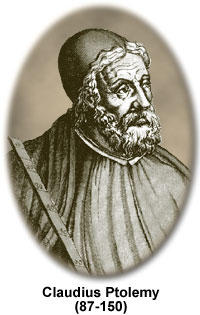Claudius Ptolemy
(Approximately 87-150)

Claudius Ptolemy was one of the most influential Greek astronomers and geographers of his time. Ptolemy propounded the geocentric theory in a form that prevailed for 1400 years. According to historians, Ptolemy was a mathematician of the very highest rank, however others believed that he committed a crime against his fellow scientists by betraying the ethics and integrity of his profession.
Very little is known of Ptolemy's life. He made astronomical observations from Alexandria in Egypt during the years 127-141. In fact, the first observation that can be dated exactly was made by Ptolemy on March 26, 127, while the last was made on February 2, 141. It was believed that he was born around 87 in Egypt and died somewhere between 150 and 165 in Alexandria Egypt. His name, Claudius Ptolemy, is a mixture derived from the Greek Egyptian 'Ptolemy' and the Roman 'Claudius'. This would indicate that he was descended from a Greek family living in Egypt, and also that he was a citizen of Rome. His citizenship probably resulted from a Roman emperor giving that 'reward' to one of Ptolemy's ancestors.
Ptolemy's major works have survived, the most important being the Almagest, which was a term derived from the original Greek name for The Mathematical Compilation. Ptolemy's Almagest, along with Euclid's Elements, shares the glory of being the scientific text longest in use. From its conception in the second Century up to the late Renaissance, this work is fundamental in determining astronomy as a science. During this time the Almagest was not just an ordinary work on astronomy; the subject of astronomy was defined as what is described in the Almagest. In this work, Ptolemy justifies his description of the universe based on the earth-centered system first described by Aristotle. This is a view of the world based upon a fixed earth, around which the sphere of the fixed stars rotates every day, thus carrying with it the spheres of the sun, moon, and planets. Ptolemy used geometric models to predict the positions of the sun, moon, and planets, using combinations of circular motion known as epicycles. Having expounded this model, Ptolemy then described the mathematics he needed to complete the rest of the work.
Ptolemy also wrote of his observations of solstices and equinoxes, and based on these observations, he determined the lengths of the seasons. He then proposed a simple model for the orbit of the sun, which was a circular motion of uniform angular velocity. The Earth was not at the center of the circle, but at a distance called the eccentricity from this center. In other books of the Almagest, he described the motion of the moon, proposed a theory of eclipses, and hypothesized that the stars always maintain the same positions relative to one another.
The final five books of the Almagest discuss planetary theory. This is widely thought to be Ptolemy's greatest achievement in terms of an original contribution. This is because there does not appear to have been any satisfactory theoretical model to explain the rather complicated motions of the five planets before Ptolemy's books. His planetary theory was a masterpiece. In it, he created a sophisticated mathematical model to fit observational data. His theory was well before its time, and the model he produced, although complicated, represented the motions of the planets well.
Ptolemy also wrote a work on astrology. It may appear strange that a scientist who wrote such excellent scientific books should dedicate any effort to a seemingly unscientific discipline such as astrology. However, Ptolemy saw it rather differently, for he claimed that while the Almagest calculates the positions of the heavenly bodies, his astrology book was a companion work describing the effects of the heavenly bodies on people's lives.
Ptolemy's major work Geography, in eight books, attempted to map the known world by giving coordinates of the major locations in terms of latitude and longitude. However, the maps drawn by Ptolemy were quite inaccurate because he was relying on data collected by questionable sources that were not associated with the Roman empire.
Another work on optics is spread over five books. This series of works was dedicated to the study of color, reflection, refraction, and mirrors of various shapes. The establishment of theory by experiment, frequently supported by the construction of special apparatus, is the most striking feature of Ptolemy's Optics. Whether the subject matter was derived or original, it is still an impressive example of the development of a mathematical science with due regard to physical data.
